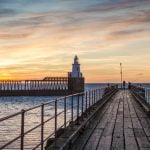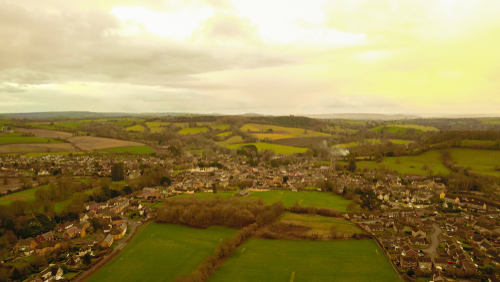
Beaminster in Brief
With a population of a little over 3,000, Beaminster is a small market town and civil parish in Dorset in the southwest of England. It’s situated approximately 15 miles (24 km) northwest of the county town Dorchester, near the source of the River Brit. The town also lies 45 miles (72 km) south of Bristol, 38 miles (61 km) west of Bournemouth, and 35 miles (56 km) east of Exeter. The town dates back to Anglo-Saxon times when it is widely believed to be a major religious centre. Thus, the town is now particularly renowned for its historic parish church, especially its tower.
A Fleeting History
The Early Days
Beaminster has its origin sometime in the 7th-century Anglo-Saxon era when it was known as Bebingmynster, meaning the church of Bebbe. There is strong historic evidence to suggest that Beaminster was the centre of a Saxon minster church and a large episcopal estate. It’s supposed that this may have acted as a catalyst for settlement of the area, though archaeological evidence to support the theory is lacking.
In the Domesday Book of 1086, the manor of Beaminster was recorded as being owned by the Diocese of Salisbury. In 1091, Bishop Osmund granted the land to two of his subordinate clergy. Beaminster went on to become a centre for the manufacture of linen and woollens. The fact that all the required raw materials for the industry were being produced locally gave the town a distinct advantage.
Beaminster Burning
At the start of the English Civil War, the town declared for Parliament but in 1644 it was sacked by Royalist forces. On Palm Sunday of 1644, Prince Maurice of the Rhine, found himself staying in Beaminster. However, he was soon forced to flee the town in much haste when a careless soldier discharged a musket into a thatched roof. The resultant fire almost razed the town to the ground. Beaminster went on to suffer two other further major fires in 1684 and 1781.
Post Industrialisation
Like much of the country, factories sprung up in the parish during the 18th and 19th centuries. Most were related to the town’s thriving flax industry, which was the area’s main employer. Much of the flax was spun and woven into sailcloth, which saw the area become a main supplier to the British Navy.
However, as is always the case, the good times weren’t to last. Historically, the town had poor connectivity, since neither the canals nor railway ever came. By the second half of the 19th century, the market for flax was in rapid decline as cotton sails and steamships had become the norm. Towards the end of the 19th century, the emergence of new technology led to major depression in the farming industry. This obviously lead to a subsequent decline in the importance and economic fortunes of the Beaminster area.
Beaminster Today
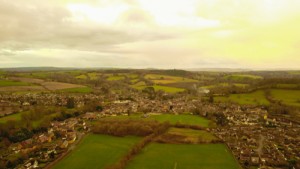
Image Credit: Tyler Nottley/Shutterstock.com
The two main employers in Beaminster are the chemical company Du Pont and the Dutch-owned Clipper Tea Company. However, the quaint village of Beaminster has very much retained its rural character, which includes an extensive array of listed buildings. Thus, this has established tourism as very much one of the pillars of the local economy.
The main event in the Beaminster calendar is the hosting of its annual music and art festival. The vintage Buckham Fair is another annual event that is held near the town. However, it was last held in 2018 and its future remains uncertain. Beaminster is twinned with the town of Saint-James on the Brittany/Normandy border in France.
Getting to Beaminster
The easiest way to get to Beaminster is by car. The main road running through the town is the A3066, which starts at its junction with the A30 at Haselbury Plucknett in the North, and runs to Bridport in the South. The fastest route for most drivers to get to Beminster is to take the M5 as far as Blackbrook roundabout and then the A538/B3168/A3066. The nearest railway station is 5 miles (8 km) away at Crewkerne, which is situated on the Western Line. Exeter International Airport is situated 30 miles (48 km) to the west of the town.
A few notable residents
- Samuel Hearne (1745 -1793) a renowned Arctic explorer, naturalist and author, lived in Beaminster as a child.
- John Makepeace is an internationally renowned furniture maker, who has lived in Beaminster since 1976.
- Martin Clunes a renowned contemporary actor, comedian, director and television presenter, has lived in Beaminster since 2013.
Sport in Beaminster
The Beaminster Community Sports Centre is the main hub for sport in the town. It boasts a full-size football pitch, rugby pitch, cricket pitch, a swimming pool and a gym, amongst other facilities.
Beaminster FC plays in the Dorset Senior League in 2021-22. It is tier 11 on the football pyramid but still worth watching if you are a fan of grassroots football.
Beaminster Cricket Club (BCC) first XI compete in the Dorset Cricket League Division 1. Both the football and cricket teams play their home games at the Memorial Ground in the centre of town.
Things to do & See in Beaminster
The town’s museum is a must-visit and discussed briefly below. However, if architecture is your thing then you are in for a treat; Practically the whole of Beaminster is Grade II listed! We are exaggerating slightly but there are currently 179! few notable buildings in town. We would be here all day covering them all so here is two must-sees to get you started.
St Mary’s Church
St Mary’s is one of the counties finest examples dating from around 1500 and is built on the site of an earlier Norman church, the 100-foot tower is one of the highest in Dorset.
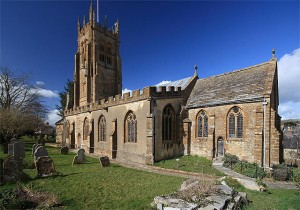
Photo © Mike Searle (cc-by-sa/2.0)
The Market Cross
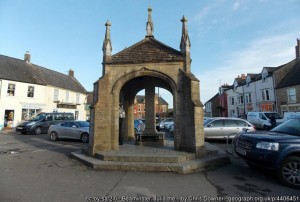
The town centre is adorned with a memorial known as Julia. It was built in 1906 by Vincent Robinson, who lived at nearby Parnham, in memory of his sister Elizabeth Julia Robinson of Parnham. It is a lovely centrepiece for the town square and a good photo opportunity too for that all-important Instagram holiday selfie.
Beaminster Museum
Is one of the country’s best small museums. Its exhibits reflect the rich social history of Beaminster and the surrounding villages of the West Dorset area. There are They often have exhibits paying homage to the towns historic place in the Flax & Sailcloth industries. Check out their website here.
Activities Nearby
There’s a surprising amount of things to see and do in or within a few miles of Beaminster. Here are a few recommendations:
- Furleigh Estate Vineyard & Winery – is reputed to make some of the best sparkling wines in the country. There are two estate tours per day on Thursdays, Fridays and Saturdays, carried out all year round. Situated just 3 miles from Beaminster in the rolling Dorset countryside, the 2-hour tours end with wine tasting and sampling of local cheeses. What’s not to like?
- Mapperton Country House – ran away with the double in 2020 by winning the Historic Houses ‘Garden of the Year’ award, and being voted No. 1 in the ‘Nation’s Finest Manor House’ poll by Country Life. Needless to say, the Jacobean manor house is famed for its magnificent gardens. You’ll find a licensed café and free parking provided at the site. The house is generally open to the public from Sunday to Thursday.
- Donkey Walking Adventures – for those who enjoy walking and/or hanging out with donkeys, here’s a unique opportunity to indulge in both pursuits at the same time. With guidance from experienced supervisors, you literally take a friendly donkey for a walk through the stunning Dorset countryside. Very therapeutic by all accounts! All walks should be booked in advance.
- UK Llamas – is a fairly unique business that’s based in Beaminster. The farm not only has llamas but also their smaller cousins, alpacas and guanacos. You can opt for just an amble around the farm or take up the informative ‘introduction to llamas’ package. For the more adventurous, you can take a day-long llama-trek along the striking Jurassic coast.
Where to Stay?
Beaminster and the surrounding area provides just about every conceivable choice in accommodation from top-end stylish country hotels to bed and breakfasts, guesthouses, inns, self-catering properties, through to camping and glamping. Thus, with such a wide choice of accommodation on offer, there should be something to suit just about everyone’s budget.
Thinking of Moving Here?
Properties in Beaminster have achieved an overall average sale price of around £340,700 over the last year. The majority of those sales were detached properties, which sold for an average price of £425,300. Terraced properties sold for an average of around £300,000, with semi-detached properties fetching £271,000. Overall, the sold price of a property in Beaminster over the last year was 20% up on the previous year.
So there you have it our Five Minute Overview of Beaminster. Before you go why not try some of our other quizzes or have a look at some of our other location guides. better still why not join our growing community it’s free and could be very rewarding going forward.


